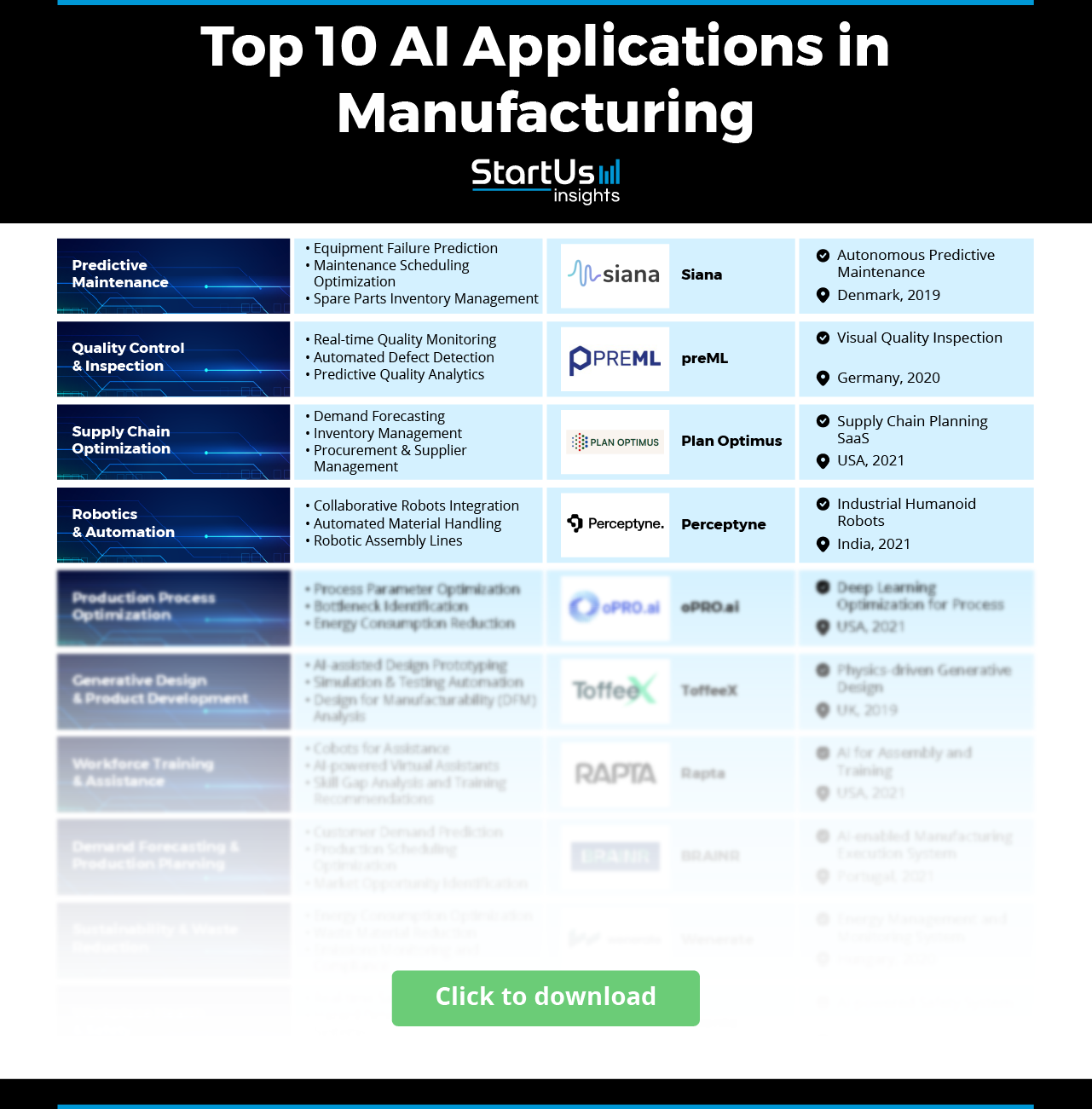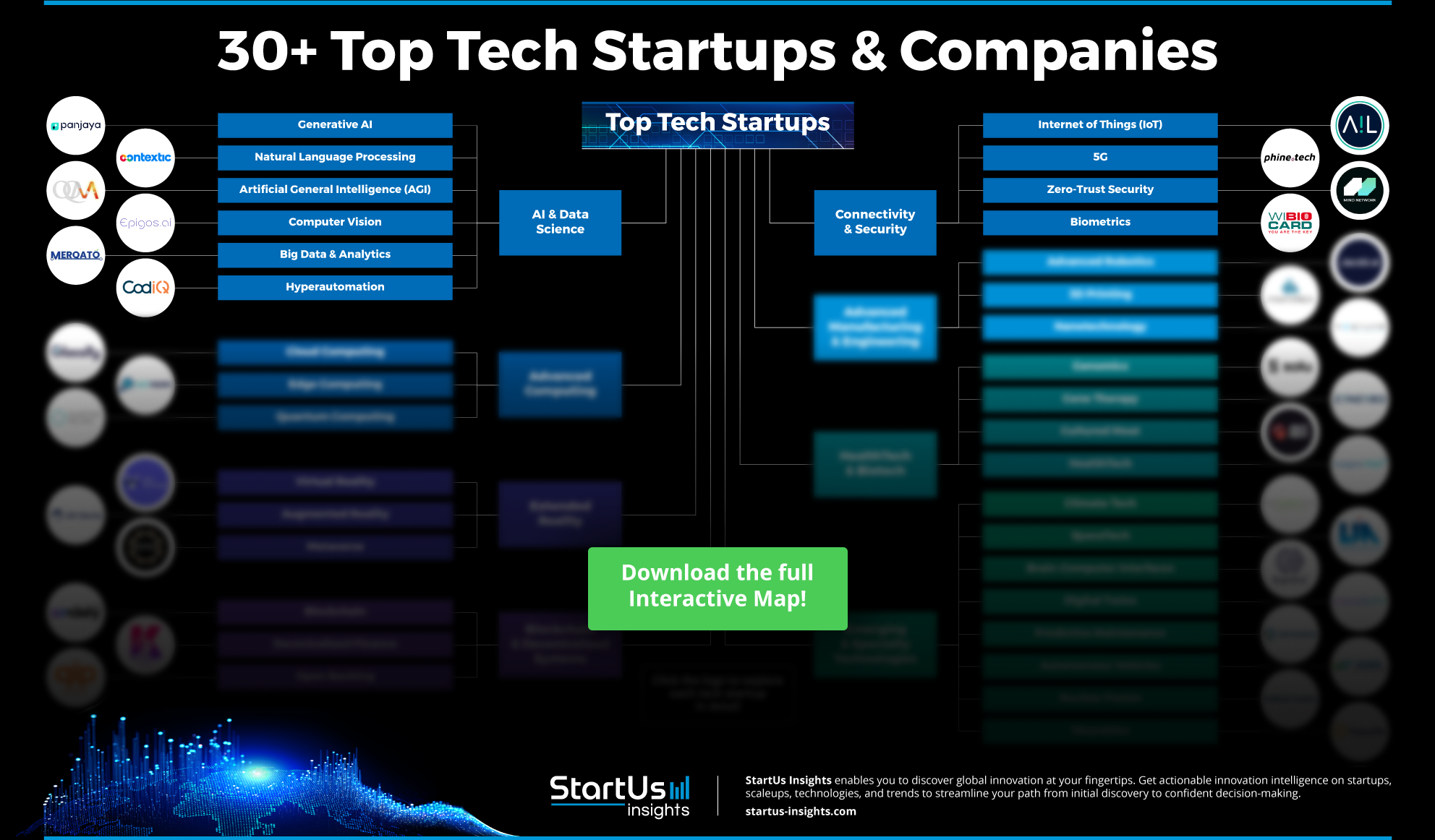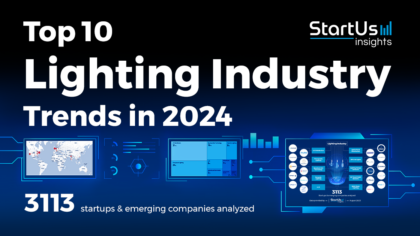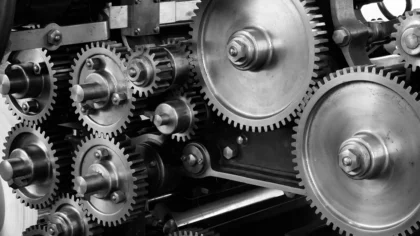Artificial intelligence (AI) addresses production efficiency, quality control, and worker safety in the manufacturing industry. Predictive maintenance with AI prevents equipment breakdowns to ensure continuous production and reduce downtimes. In quality control, AI-driven solutions like preML’s visual inspection technology improve defect detection and product consistency. AI also optimizes supply chains to streamline inventory management and ensure timely deliveries.
Further, robotics and automation enhance manufacturing efficiency, while AI-based production process optimization improves resource allocation. AI supports generative design to speed up product development and provides intelligent training systems for the workforce. Startups like Invanta use AI to enhance safety protocols and mitigate risks in industrial environments. As AI’s role in demand forecasting, sustainability, and operational optimization grows, stakeholders must adopt these innovations to stay competitive and ensure long-term growth in the evolving AI and manufacturing landscape.
Why should you read this report?
- Gain in-depth insights into the top 10 AI applications in the manufacturing sector
- Learn about three practical AI in manufacturing use cases for each application
- Meet 10 innovative startups advancing these manufacturing solutions

Key Takeaways
- Predictive Maintenance
- Use Cases:
- Equipment Failure Prediction
- Maintenance Scheduling Optimization
- Spare Parts Inventory Management
- Startup to Watch: Siana
- Use Cases:
- Quality Control & Inspection
- Use Cases:
- Real-time Quality Monitoring
- Automated Defect Detection
- Predictive Quality Analytics
- Startup to Watch: preML
- Use Cases:
- Supply Chain Optimization
- Use Cases:
- Demand Forecasting
- Inventory Management
- Procurement and Supplier Management
- Startup to Watch: Plan Optimus
- Use Cases:
- Robotics & Automation
- Use Cases:
- Collaborative Robots Integration
- Automated Material Handling
- Robotic Assembly Lines
- Startup to Watch: Perceptyne
- Use Cases:
- Production Process Optimization
- Use Cases:
- Process Parameter Optimization
- Bottleneck Identification
- Energy Consumption Reduction
- Startup to Watch: oPRO.ai
- Use Cases:
- Generative Design & Product Development
- Use Cases:
- AI-assisted Design Prototyping
- Simulation & Testing Automation
- Design for Manufacturability (DFM) Analysis
- Startup to Watch: ToffeeX
- Use Cases:
- Workforce Training & Assistance
- Use Cases:
- Cobots for Assistance
- AI-powered Virtual Assistants
- Skill Gap Analysis and Training Recommendations
- Startup to Watch: Rapta
- Use Cases:
- Demand Forecasting & Production Planning
- Use Cases:
- Customer Demand Prediction
- Production Scheduling Optimization
- Market Opportunity Identification
- Startup to Watch: BRAINR
- Use Cases:
- Sustainability and Waste Reduction
- Use Cases:
- Energy Consumption Optimization
- Waste Material Reduction
- Emissions Monitoring and Compliance
- Startup to Watch: Wenerate
- Use Cases:
- Workplace Health and Safety
- Use Cases:
- Real-time Safety Monitoring
- Hazard Detection and Alert Systems
- Incident Prediction and Prevention
- Startup to Watch: Invanta
- Use Cases:
AI in Manufacturing FAQs
How is AI used in manufacturing?
AI enhances efficiency, reduces costs, and optimizes manufacturing processes. Predictive maintenance uses machine learning algorithms to analyze machinery data and predict failures. This allows manufacturers to schedule maintenance proactively to reduce downtime and save costs. Quality control employs computer vision to analyze visual data from production lines and detect defects to ensure only quality products reach the market. Further, AI-driven production planning optimizes resources and streamlines scheduling by predicting demand and adjusting production schedules to reduce lead times and improve operational efficiency.
How big is AI in the manufacturing market?
The global AI in manufacturing market is projected to grow from USD 3.8 billion in 2023 to USD 156.1 billion by 2033, with a compound annual growth rate (CAGR) of 45% from 2024 to 2033. This growth is driven by the adoption of AI technologies across industries such as automotive, electronics, and heavy machinery.
How We Identify Emerging Technologies & Startups
The data in this report originates from StartUs Insights’ Discovery Platform, covering 4.7+ million global startups, scaleups, and technology companies, alongside 20K emerging technology trends. Our platform makes startup and technology scouting, trend intelligence, and patent searches more efficient by providing deep insights into the technological ecosystem. Utilizing the trend intelligence feature, we analyze industry-specific technologies for this report, detect patterns and trends, and identify use cases along with the startups advancing these areas. Further details and capabilities are accessible via the website.
10 Top Applications of Artificial Intelligence in Manufacturing[2025 & Beyond]
1. Predictive Maintenance
AI enables predictive maintenance in manufacturing by predicting equipment failures before they occur. This reduces downtime, extends machinery life, and lowers maintenance costs. AI systems use machine learning algorithms to analyze sensor data and historical records to detect patterns and provide real-time insights into machinery conditions. It saves costs by focusing maintenance on equipment that needs attention and extends equipment lifespan through timely interventions. AI-powered predictive maintenance enhances workplace safety by reducing the risk of accidents caused by malfunctions and improves operational efficiency by ensuring machinery operates at peak performance. It has applications across various industries, including automotive and energy, where equipment reliability is critical.
3 Practical Use Cases of AI in Predictive Maintenance
- Equipment Failure Prediction: Techniques like deep learning and neural networks model complex machinery behavior. They analyze extensive sensor data to predict specific equipment failures that enable targeted maintenance.
- Maintenance Scheduling Optimization: AI optimizes maintenance schedules using algorithms such as genetic algorithms and reinforcement learning. This balances equipment service needs with production demands to minimize operational disruptions and maximize machinery availability.
- Spare Parts Inventory Management: Predictive analytics forecast the demand for spare parts by correlating equipment usage patterns with failure rates. Machine learning models allow for maintaining optimal inventory levels to reduce carrying costs and ensure parts are available when needed to prevent maintenance delays.
Startup to Watch: Siana
Danish startup Siana offers autonomous predictive maintenance for industrial machinery. It uses sensors and machine learning algorithms to monitor equipment performance. Its Siana Platform summarizes each machine’s health status with color-coded indicators and alerts. This allows for assessing machine conditions and scheduling maintenance to prevent breakdowns. The Siana App simplifies installation and setup with a step-by-step interface, using NFC to connect devices and verify functionality. Also, the Siana Device collects data on vibration and temperature to transmit it through mobile networks for analysis. The device is wireless, battery-powered, and durable with an IP69K rating. Siana’s solutions enable manufacturing companies to optimize maintenance, extend machine life, reduce costs, and improve operational efficiency.
2. Quality Control & Inspection
Traditional quality control methods rely on human inspectors, which is time-consuming and prone to errors due to fatigue and subjective judgment. AI-driven systems use machine learning algorithms and computer vision to analyze large amounts of data to detect small defects that might escape human observation. AI also ensures compliance with regulatory standards, minimizes safety hazards, and enhances brand reputation by consistently delivering high-quality products. Integrating AI with existing manufacturing processes facilitates automated inspections that are scalable and adaptable to changes in production volume, thereby optimizing efficiency.
3 Practical Use Cases of AI in Quality Control & Inspection
- Real-time Quality Monitoring: Internet of Things (IoT) sensors and edge computing to process data instantly on the production line. Machine learning algorithms analyze this data to identify deviations from quality standards that enable immediate corrective actions without human intervention.
- Automated Defect Detection: Computer vision systems use deep learning models to automatically detect defects in products during manufacturing. High-resolution cameras capture images, and convolutional neural networks analyze them to identify imperfections with higher accuracy than manual inspections.
- Predictive Quality Analytics: AI uses predictive analytics to forecast potential quality issues before they occur. By applying machine learning algorithms to historical production data, these systems predict trends and anomalies that allow manufacturers to proactively adjust processes and reduce defect rates.
Startup to Watch: preML
German startup preML provides AI-powered visual quality inspection solutions for manufacturing. Its CVC Inspect module uses AI to process image data in real time to identify defects, anomalies, and errors in components. This system handles image acquisition, object detection, and error classification. The CVC Control dashboard offers remote access to real-time visualizations, comprehensive reports, and documentation to support data-driven decision-making and process optimization. The startup’s Power Edge device, featuring NVIDIA hardware, performs in challenging environments with its IP housing and shock resistance. This edge device supports high-speed processing while reducing data transmission needs. Further, preML customizes cameras for specific use cases and environments to ensure optimal inspection conditions. It also supports lighting and installation that integrates the visual inspection system into existing workflows to improve operational efficiency and reduce costs.
3. Supply Chain Optimization
The manufacturing systems use machine learning algorithms to analyze data that enables accurate demand forecasting, optimized inventory management, and streamlined logistics. AI facilitates real-time monitoring and decision-making to identify inefficiencies and recommend corrective actions. AI-driven automation reduces manual tasks, eliminates errors, and enhances operational efficiency across the supply chain. By optimizing routes and delivery schedules, AI contributes to faster deliveries and reduces bottlenecks. AI also enhances supply chain transparency and sustainability by providing insights into energy management and resource allocation. This allows manufacturers to achieve cost savings while maintaining high service levels and adapting to market demands.
3 Practical Use Cases of AI in Supply Chain Optimization
- Demand Forecasting: Algorithms like deep learning and machine learning ensembles analyze complex datasets. AI models process information such as consumer behavior patterns, market trends, and economic indicators to predict future demand accurately. This allows manufacturers to adjust production schedules and resources to meet market needs.
- Inventory Management: Using reinforcement learning and predictive modeling, AI systems manage stock levels by considering lead times, sales velocity, and supply chain disruptions. This reduces holding costs, minimizes stockouts or overstock situations, and improves inventory turnover rates.
- Procurement and Supplier Management: Natural language processing and data mining techniques evaluate supplier performance and market conditions. Machine learning algorithms assist in supplier selection by analyzing reliability, cost, and compliance data. Also, AI-driven platforms automate contract negotiations and risk assessments.
Startup to Watch: Plan Optimus
US startup Plan Optimus offers SaaS for supply chain planning and optimization. It uses AI-driven demand forecasting and mathematical optimization to streamline production planning, inventory management, and logistics. Its solutions include Supply Chain Master Planning (SCMP) to balance demand and supply, Optimized Procurement Planning (OPP) to sync procurement with strategies, and Production Planning & Scheduling (PPS) to align production capacity with demand. Further, the Demand Planning (DP) tool provides AI-powered forecasting for real-time decision-making. Plan Optimus enables manufacturing companies to align supply chain strategies with business objectives to reduce costs and enhance responsiveness.
4. Robotics & Automation
AI-powered robots perform complex tasks with more accuracy and speed than traditional methods. This reduces the need for manual labor and minimizes human error. Robots learn from data, adapt to new scenarios, and make autonomous decisions, which is crucial for tasks like assembly, welding, and painting in automotive and electronics manufacturing. AI enables real-time adjustments and quality assurance on production lines to ensure precision and minimize waste. AI-driven automation supports customized production by adjusting processes in real time to meet specific consumer demands.
3 Practical Use Cases of AI in Robotics & Automation
- Collaborative Robots Integration: AI enables collaborative robots, or cobots, to work safely alongside human workers. Using real-time perception and adaptive learning algorithms, these robots interpret human actions and gestures to facilitate teamwork and increase productivity without compromising safety.
- Automated Material Handling: Leveraging AI optimizes the movement and storage of materials within manufacturing facilities. AI systems use predictive analytics and path optimization algorithms to manage robotic transport units to ensure efficient routing, reduce bottlenecks, and synchronize material flow with production schedules.
- Robotic Assembly Lines: Use machine learning models to adapt to changing product designs and production requirements. These systems enable robots to adjust assembly processes in real time to support mass customization and improve efficiency by minimizing downtime associated with reconfiguration.
Startup to Watch: Perceptyne
Indian startup Perceptyne develops industrial humanoid robots for sectors like electronics and automotive manufacturing. Its product, the PR-34D, combines AI with robotics for precise assembly and packaging tasks. The PR-34D has dual 7-degree-of-freedom arms and 10-degree-of-freedom grippers that offer good reach and object handling. Its vision-guided technology and tactile sensing improve adaptability in dynamic environments. Perceptyne’s solution reduces infrastructure changes and dependency on system integrators to streamline manufacturing workflows and enhance operational efficiency.
5. Production Process Optimization
Leveraging machine learning algorithms and data analytics, AI systems streamline workflows, reduce production times, and increase profit margins. They identify inefficiencies and provide real-time recommendations for process improvements. These technologies enable manufacturers to adjust production parameters dynamically to ensure optimal resource use and minimize waste. AI-driven tools simulate new scenarios using digital twin technology that allows manufacturers to test and refine processes in a virtual environment before implementing changes on the factory floor. This improves product quality and sustains production levels by predicting potential disruptions and enabling proactive management. AI also enhances customization by adjusting production processes in real-time to meet specific consumer demands to offer flexibility and responsiveness to market changes.
3 Practical Use Cases of AI in Production Process Optimization
- Process Parameter Optimization: AI applies machine learning techniques like reinforcement learning and genetic algorithms to fine-tune production parameters. By simulating various settings and predicting their outcomes, AI systems identify optimal conditions that maximize efficiency and product quality while minimizing costs, without relying on manual trial-and-error methods.
- Bottleneck Identification: Using process mining and data analytics, AI identifies bottlenecks within manufacturing workflows by analyzing production data and performance metrics. Machine learning algorithms detect inefficiencies and constraints in real time which enables managers to address specific issues promptly to enhance throughput and reduce operational delays.
- Energy Consumption Reduction: By monitoring energy consumption patterns and correlating them with production activities, machine learning models recommend adjustments to equipment operation and scheduling. This reduces energy waste, lowers operational costs, and decreases the environmental footprint.
Startup to Watch: oPRO.ai
US startup oPRO.ai develops AI-Pilot to optimize manufacturing processes using AI/ML technology. The solution analyzes and refines raw data with a pipeline tool suite that cleans data, identifies key AI/ML tags, and categorizes control, manipulated, and disturbance variables for modeling. The system uses adaptive machine learning and non-deterministic AI software to re-learn and improve system dynamics in a supervised autonomous steering mode. This optimization increases yield, supports quick decision-making, enables “what-if” scenario simulations, and enhances safety and stability across operations. By configuring AI for specific use cases, oPRO.ai ensures intelligent process automation that improves operational efficiency and process stability and aids manufacturers in minimizing downtime and utilizing resources better.

6. Generative Design & Product Development
Generative design AI uses algorithms to create optimal designs based on goals and constraints like material usage, structural integrity, cost, and performance. This technology explores design alternatives that allow manufacturers to iterate and refine concepts quickly to shorten the design cycle and reduce time-to-market. AI generates innovative solutions that human designers might not consider, which results in lightweight, structurally sound, and cost-effective products. It also facilitates product customization by generating design variations tailored to specific customer requirements that enable manufacturers to offer personalized products. Further, AI-driven generative design supports sustainable manufacturing by optimizing material selection and usage to reduce waste and enhance energy efficiency.
3 Practical Use Cases of AI in Generative Design & Product Development
- AI-assisted Design Prototyping: Generating detailed virtual models using machine learning algorithms, engineers simulate and evaluate design performance digitally. This allows for rapid iteration and refinement without physical prototypes to save time and resources.
- Simulation & Testing Automation: Using techniques like neural networks and predictive analytics, AI systems predict product behavior under various conditions. It improves accuracy and efficiency in testing while reducing development cycles.
- Design for Manufacturability (DFM) Analysis: AI uses data analytics and optimization algorithms to assess designs for manufacturability. By evaluating production capabilities, material constraints, and cost implications, AI allows engineers to modify designs to ensure they are practical and cost-effective to produce.
Startup to Watch: ToffeeX
UK startup ToffeeX develops a cloud-based, physics-driven generative design software that optimizes engineering designs using physics simulations. It allows engineers to define design parameters and constraints, and the software generates designs balancing performance factors like fluid dynamics and thermal efficiency. The startup’s software creates designs for components such as heat sinks, cold plates, and manifolds. It leverages multi-objective optimization to ensure designs are manufacturable across processes like 3D printing, milling, and chemical etching. This process allows engineers to explore multiple alternatives while achieving sustainable, high-performance results. ToffeeX enables manufacturers to streamline design cycles, reduce costs, and bring innovative products to market faster.
7. Workforce Training & Assistance
Training programs created through AI allows it to be tailored to individual employee needs, considering skill levels, job roles, and performance data. This ensures each worker receives relevant training to improve knowledge retention and skill development. AI also facilitates virtual simulations and real-time feedback that lets employees practice complex tasks in a controlled environment to enhance learning outcomes and safety. Moreover, AI-powered tools predict skills gaps by analyzing workforce data that enables proactive training interventions to keep the workforce aligned with industry demands. AI accelerates the training process, making it more accessible and effective, which aids manufacturers to ensure their workforce remains competitive and adaptable.
3 Practical Use Cases of AI in Workforce Training & Assistance
- Cobots for Assistance: Work alongside human employees on the manufacturing floor. They are equipped with machine learning algorithms and advanced sensors and adapt to human actions in real-time, assisting with tasks that require precision or are ergonomically challenging.
- AI-powered Virtual Assistants: Use natural language processing and machine learning to provide real-time support to manufacturing workers. These assistants offer on-demand information, step-by-step procedural guidance, and troubleshooting help through voice or text interfaces.
- Skill Gap Analysis and Training Recommendations: AI systems use advanced analytics and data mining to identify skill gaps within the workforce by analyzing performance data, learning progress, and emerging industry requirements. Machine learning models generate personalized training recommendations for each employee.
Startup to Watch: Rapta
US startup Rapta builds an AI Supercoach platform that automates and optimizes assembly and training by mimicking human visual processing. The platform captures video of expert workers performing tasks like wire harnesses or mechanical assembly and analyzes the sequence using deep learning. The startup’s AI, based on convolutional neural networks, learns to replicate the expert’s actions and monitors the assembly process in real time to ensure each step is performed correctly. It provides immediate feedback when it detects errors, such as misplaced components or incorrect wiring, that allows workers to correct mistakes without supervisor intervention. Rapta also continuously trains workers by offering live, visual guidance to accelerate workforce development while maintaining quality control throughout production.
8. Demand Forecasting & Production Planning
AI algorithms analyze historical sales data, market trends, and external factors to produce accurate demand forecasts. This allows manufacturers to anticipate shifts in customer preferences and adjust production plans. The improved accuracy minimizes risks of overproduction or stockouts that lead to efficient inventory management and cost reductions. AI also optimizes production scheduling by integrating real-time data on demand fluctuations, resource availability, and production constraints. This keeps manufacturing processes agile and responsive to changes. Further, AI-driven systems simulate various production scenarios that enable manufacturers to understand the impact of changes in demand or supply chain disruptions and make informed decisions.
3 Practical Use Cases of AI in Demand Forecasting & Production Planning
- Customer Demand Prediction: Machine learning algorithms, including time series analysis and neural networks, forecast demand by processing diverse datasets. Beyond historical sales and market trends, AI leverages external factors such as seasonality and macroeconomic indicators. This gives manufacturers deeper insights into shifts in consumer behavior and enables more precise inventory adjustments.
- Production Scheduling Optimization: AI uses optimization techniques, such as reinforcement learning, to dynamically adjust production schedules. Unlike traditional methods, AI continuously updates scheduling plans based on real-time data on machine performance, workforce availability, and supply chain disruptions. This ensures maximum resource efficiency, minimizing downtime and bottlenecks.
- Market Opportunity Identification: By analyzing unstructured data from customer reviews, social media, and industry reports, AI identifies new trends and unmet needs. This proactive insight enables manufacturers to innovate and design products better aligned with future market demands.
Startup to Watch: BRAINR
Portuguese startup BRAINR provides an AI-enabled, cloud-based manufacturing execution system (MES) to optimize factory operations. The platform manages the production process, including inbound logistics, warehouse management, production scheduling, and dispatch. The startup’s system integrates with ERPs and IoT devices to offer real-time visibility and control over operations. Its key features include predictive analytics for production planning, automated quality control, and traceability tools. Further, BRAINR system’s mobile compatibility enhances accessibility and enables manufacturers to increase efficiency and streamline processes across the factory floor.
9. Sustainability and Waste Reduction
Manufacturers use AI to optimize resource allocation, improve energy efficiency, and minimize waste generation to promote sustainable practices. AI-driven analytics identify inefficiencies in production processes and suggest improvements to reduce energy consumption and waste. AI facilitates real-time monitoring and adjustments to optimize energy use and minimize waste production. Additionally, AI enhances quality control by detecting defects early in the production process to reduce faulty products and associated waste. AI also aids in transitioning towards a circular economy by promoting recycling and reusing materials to reduce the environmental footprint of manufacturing operations.
3 Practical Use Cases of AI in Sustainability & Waste Reduction
- Energy Consumption Optimization: By predicting energy needs across production stages and integrating with smart energy systems, AI systems allocate resources efficiently. Reinforcement learning schedules energy-intensive tasks during off-peak hours to reduce energy consumption and operating costs while maintaining efficiency.
- Waste Material Reduction: Predictive analytics forecast material needs and align production with demand to minimize overproduction and waste. Machine learning optimizes production workflows to prevent excess inventory and ensure the use of necessary resources, reducing material waste.
- Emissions Monitoring & Compliance: Real-time emissions tracking is enabled by analyzing data from IoT-connected sensors throughout the production facility. Machine learning processes this data to predict compliance risks that allow manufacturers to adjust operations to stay within regulatory limits, reduce emissions, and improve sustainability.
Startup to Watch: Wenerate
Hungarian startup Wenerate develops an energy management and monitoring platform that allows manufacturing companies to track their energy consumption. The system integrates monitoring, custom reports, and automated alerts to optimize energy efficiency. Its features include carbon emissions monitoring, regulatory compliance, and participation in energy-saving tenders. The startup’s solution also offers submetering for energy usage measurement that enables companies to identify cost-saving opportunities, improve operational efficiency, reduce carbon footprints, and maintain compliance without significant investment.
10. Workplace Health and Safety
AI systems use computer vision, machine learning, and IoT sensors to monitor manufacturing environments for safety hazards like spills, equipment malfunctions, or non-compliance with safety protocols. These systems detect anomalies in real time and issue alerts to workers or supervisors that enable immediate actions to prevent accidents and injuries. Predictive maintenance powered by AI analyzes equipment data to foresee potential failures to reduce the likelihood of sudden breakdowns and associated risks. AI-driven automation also reduces human exposure to dangerous tasks by deploying robots or drones for inspections and hazardous material handling. AI’s role in workplace safety lowers workplace injuries, reduces associated costs such as workers’ compensation, and enhances emergency response by delivering rapid alerts and data-driven insights for swift interventions during critical situations.
3 Practical Use Cases of AI in Workplace Health & Safety
- Real-time Safety Monitoring: AI-enabled wearable devices and biometric sensors track employees’ health metrics, such as heart rate, fatigue, and exposure to environmental risks. Machine learning models analyze this data in real-time to provide instant feedback to prevent potential health-related incidents like exhaustion or heatstroke in high-risk environments.
- Hazard Detection and Alert Systems: Leveraging computer vision and IoT-connected sensors, AI systems detect various safety hazards, such as equipment malfunctions or unauthorized access. By continuously analyzing camera feeds and sensor data, these systems generate immediate alerts to notify relevant personnel to take corrective action before an incident occurs.
- Incident Prediction and Prevention: Predictive analytics anticipate potential safety risks by identifying patterns in employee behavior and equipment performance data. Machine learning models detect early warning signs of accidents that enable companies to proactively implement safety measures, update protocols, and provide targeted training to mitigate risks before incidents occur.
Startup to Watch: Invanta
Based out of the Czech Republic, Invanta is a startup that creates an AI-powered safety system for industrial environments. It recognizes dangerous situations around machinery and triggers immediate actions. The system uses real-time video analysis and image recognition with neural networks to detect hazards like missing personal protective equipment (PPE) or human proximity in high-risk areas. It offers features such as faint detection, robotic safety control, and high-voltage protection. Invanta’s system improves safety standards, reduces accidents, and optimizes internal logistics.
Leverage Emerging AI in Manufacturing Technologies
Key investors like Y Combinator, Techstars, Alumni Ventures, Entrepreneur First, and Intel Ignite support AI-focused startups in the manufacturing sector. They provide essential resources to drive innovation. The funding spans various stages, including seed funding, early-stage VC, Series A, pre-seed, and angel investments. These investments are crucial for developing and scaling new technologies.
Act now on the emerging AI technologies transforming the manufacturing industry. With StartUs Insights, you swiftly discover hidden gems among over 4.7 million startups, scaleups, and tech companies, supported by 20K+ trends and technologies. Our AI-powered search and real-time database ensure exclusive access to innovative solutions, making the global innovation landscape easy to navigate.
Trusted by industry leaders like Samsung, Nestlé, and Magna, we provide unmatched data, a 360-degree industry view, and data-driven intelligence for confident strategic decisions. For instance, here is what Gianluca Grifi, Business Creation Manager of EIT Manufacturing says about our platform, “StartUs Insights’ reach enables us to attract a high number of relevant startups in a short amount of time as well as strengthen EIT Manufacturing’s brand in the global startup community.”
Like them, you can also leverage our innovation services to optimize costs, streamline operations, and stay ahead of the curve. Get in touch today to explore how our comprehensive innovation intelligence can drive your success.
Discover All AI-led Manufacturing Technologies & Startups!
![AI and Manufacturing: 10 Use Cases You Need to Know [2025 & Beyond]](https://www.startus-insights.com/wp-content/uploads/2024/10/AI-and-Manufacturing-SharedImg-StartUs-Insights-noresize-420x236.webp)







